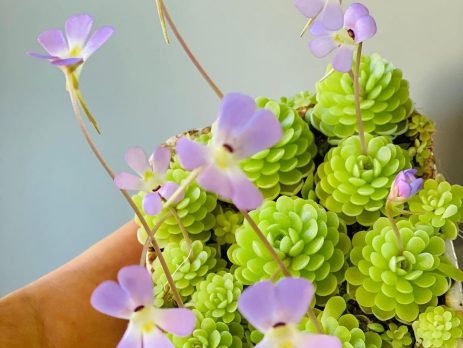What are some interesting facts about butterworts?
Butterworts, scientifically known as Pinguicula, are a group of carnivorous plants known for their striking appearance and unique trapping mechanisms. Here are some interesting facts about butterworts:
- Carnivorous Adaptation: Like other carnivorous plants, butterworts have evolved to capture and digest insects and other small prey to obtain essential nutrients, especially in nutrient-poor soils.
- Lack of Active Movement: Unlike some carnivorous plants like sundews, butterworts do not have active movements to trap prey. Instead, they rely on a passive adhesive trapping mechanism.
- Glandular Leaves: Butterwort leaves are covered with glandular hairs that secrete a sticky, mucilaginous substance. Insects that come into contact with the mucilage become trapped.
- Rosette Growth: Butterworts typically form basal rosettes of leaves that lie flat on the ground. The leaves can vary in size and shape, depending on the species.
- Attractive Colors: The leaves of many butterwort species are often colorful, ranging from green to reddish or purple hues. These colors may attract insects to the mucilage-covered surface.
- Diverse Species: There are over 80 species of butterworts, and they can be found in various parts of the world, including North and South America, Europe, Asia, and Australia.
- Habitat: Butterworts are often found in damp, nutrient-poor environments such as bogs, marshes, and rocky outcrops. They are especially common in regions with acidic soils.
- Leaf Morphology: Butterwort leaves come in various shapes and sizes, depending on the species. Some have broad, flat leaves, while others have more slender, elongated leaves.
- Prey Capture: Insects and other small prey that become stuck to the mucilage are slowly digested by enzymes secreted by the plant. Nutrients from the prey are absorbed by the leaf surface.
- Seasonal Growth: Butterworts often experience seasonal growth patterns, with new leaves emerging in the spring and older leaves dying back in the winter.
- Pollination: Butterworts produce attractive flowers to attract pollinators, such as bees and flies. The flowers can be various colors, including shades of purple, pink, and yellow.
- Conservation: While not all butterwort species are endangered, some are at risk due to habitat destruction and overcollection. Conservation efforts are in place to protect vulnerable species.
- Cultivation: Butterworts are cultivated as ornamental plants by enthusiasts who appreciate their unique appearance and carnivorous behavior. They require specific care, including well-draining, acidic soil.
- Hybridization: Hybridization between different butterwort species and even other carnivorous plant genera has led to the creation of a wide range of hybrid varieties.
- Medicinal Uses: Some indigenous cultures have used butterwort extracts for their potential medicinal properties, including treating respiratory issues and digestive problems.
Butterworts are captivating carnivorous plants with their passive trapping mechanism and colorful appearance. Their ability to thrive in nutrient-poor environments and their intriguing adaptations make them a subject of interest for botanists, horticulturists, and plant enthusiasts.


Leave a Reply
You must be logged in to post a comment.